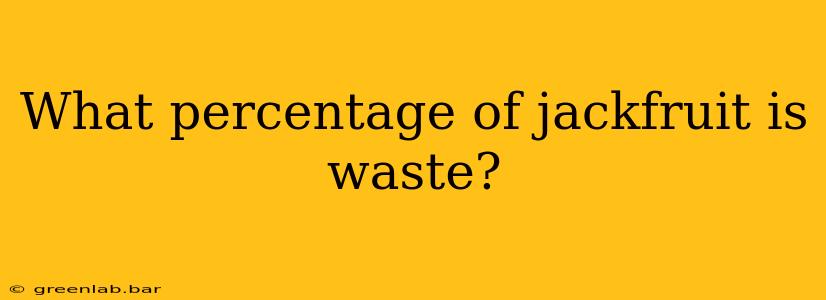Decoding Jackfruit Waste: A Look at the Numbers and Solutions
Jackfruit, the world's largest tree fruit, is increasingly popular for its versatility and meat-like texture. However, a significant portion of this bountiful fruit often ends up as waste. Pinpointing an exact global percentage is challenging due to variations in farming practices, processing techniques, and regional consumption patterns. However, we can explore the various stages where jackfruit waste occurs and estimate the overall impact.
Stages of Jackfruit Waste Generation:
1. Pre-harvest Losses: These losses occur before the jackfruit even reaches the market. Factors contributing to pre-harvest waste include:
- Pest and Disease Damage: Insects, fungal infections, and other diseases can significantly reduce yield and quality, leading to discarded fruit.
- Improper Harvesting Techniques: Untimely or rough harvesting can damage the fruit, making it unsuitable for sale or processing.
- Lack of Storage Facilities: Inadequate storage facilities in rural areas can lead to spoilage before the jackfruit can be transported.
While precise figures for pre-harvest losses are scarce, reports from developing countries indicate that losses can be substantial, sometimes exceeding 20-30% depending on factors like climate and farming practices.
2. Post-harvest Losses: These losses occur after harvesting but before consumption. Significant wastage happens due to:
- Spoilage during Transportation and Storage: Improper handling and inadequate cooling during transportation and storage lead to rapid deterioration and spoilage.
- Processing Inefficiencies: Inefficient processing methods lead to significant waste, particularly during the peeling, coring, and seed removal stages. Much of the rind, core, and seeds are typically discarded.
- Market Rejection: Fruit deemed aesthetically imperfect (e.g., bruises, blemishes) might be rejected by markets, contributing to post-harvest losses.
Estimates for post-harvest losses vary widely depending on the region and infrastructure. Studies in Southeast Asia, a major jackfruit-producing region, suggest post-harvest losses can range from 10% to over 50%, depending on the level of technology and market access.
3. Consumer Waste: Even when jackfruit reaches the consumer, a portion may end up as waste due to:
- Overbuying: Consumers may purchase more jackfruit than they can consume before it spoils.
- Improper Storage at Home: Incorrect storage conditions at home can lead to spoilage and waste.
- Food Preparation Inefficiencies: Inability to effectively utilize all parts of the jackfruit can result in waste.
Estimating consumer waste is difficult, but anecdotal evidence and observations suggest that a significant portion of purchased jackfruit goes uneaten or discarded.
Overall Estimation and Challenges:
Combining pre-harvest, post-harvest, and consumer waste, it's difficult to provide a definitive global percentage for total jackfruit waste. However, considering the significant losses at each stage, it's reasonable to estimate that a substantial portion (potentially 30-50% or more) of the total jackfruit produced is wasted globally. This is a conservative estimate, and the actual figure likely varies across regions.
The lack of comprehensive data collection and standardized methodologies for quantifying jackfruit waste presents a major challenge in determining an exact percentage. More research is needed to accurately assess the extent of waste at each stage of the supply chain in various regions.
Reducing Jackfruit Waste: Solutions for the Future
Addressing jackfruit waste requires a multi-pronged approach focusing on:
- Improved Farming Practices: Implementing sustainable agricultural techniques, disease management, and proper harvesting methods.
- Enhanced Post-Harvest Handling: Investing in better transportation, storage, and processing technologies.
- Value-Addition Strategies: Exploring ways to utilize the currently discarded parts of the jackfruit, such as the rind, core, and seeds, for various products (e.g., flour, animal feed, cosmetics).
- Consumer Education: Raising awareness among consumers about proper storage and utilization of jackfruit to minimize household waste.
By addressing these challenges, we can significantly reduce jackfruit waste and ensure that this nutritious and versatile fruit contributes more effectively to global food security and sustainable agriculture.

